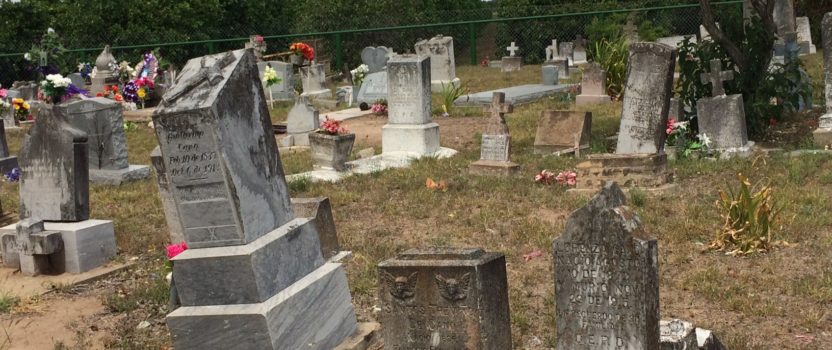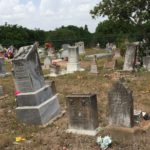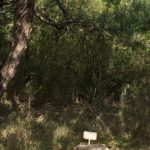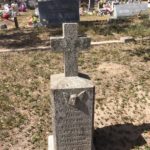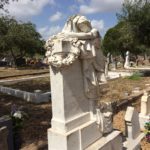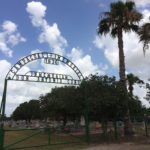Mercedes’ Historic Cemeteries
Mercedes’ six cemeteries have stories to tell, if you take the time to listen. While some of the stories are tied to those we have lost, walking between weathered tombstones you also find links to a shared heritage and a not-so-distant past. Five of the graveyards are designated Texas Historic Cemeteries, with the oldest birthdates reaching back to the early 1800s.
The tranquility and shade thrown by oak, ebony mesquite and olive trees feels like a blessing in the summer heat. You will recognize names in Mercedes’ cemeteries. You can take a moment to appreciate the people in your life, those you have known. The Spanish equivalent of Rest In Peace – EPD – appears on many markers.
Tucked in the middle of citrus groves north of the junction of Mile 9 and Mile One West, the Campacuas Cemetery takes you back more than 180 years to the hardy settlers who ventured north of the Rio Grande. Campacuas Lake, a resaca, was named after the Tampacuaze Indians who frequented the area, according to the Texas Historic Cemetery marker.
In 1836, Antonio Cano established Rancho Guadalupe at Campacuas on the Llano Grande land grant. The earliest graves at Campacuas Cemetery had wooden markers which floods washed away. The oldest marked site and the most visible one is that of Don Antonio, an above ground crypt from 1877.
Well-tended and compact, Campacuas Cemetery has more stone crosses than tombstones amid the daisies, olive trees and salt cedar. Toy marbles are pressed into the concrete cross above a small grave. Solar-powered lights edge the grave of a loved one gone almost 75 years. The Campacuas Cemetery Association holds an annual November homecoming to clean and decorate graves.
The intersection of Anacahuitas Street and Mile 1 West marks the location of Immanuel Lutheran (graves face in every direction), Cemeterio Bautista (graves face east), and Our Lady of Mercy Cemetery (graves face north).
Our Lady of Mercy Cemetery opened in 1909 on land given by the Capisallo Town & Improvement Co. for those not buried on private ranches outside of Mercedes. A tall crucifix, a memorial to Father Pedro Keralum of Oblates of Mary Immaculate, dominates the skyline. The French architect and missionary on horseback died in 1872 although the marker dates to 1920, erected by his fellow religious.
Above ground crypts and grand markers stand next to weathered, nearly-forgotten ones. Old worn stones tempt visitors to consider a gravestone rubbing or a cleaning to read the inscription. The children’s graves are the most poignant: the stuffed toy on the grave of a child gone now 14 years; the twins who died at birth. Yet others lived to 98 and 99. La vide es un regal de Dios.
Flags mark the graves of those who served in World War I, World War II, Korea and Vietnam. Some family plots have no grass, by design. A shiny tilted-heart marble marker dates from 1960. One plot has a marble bench, instead of a standard marker, with life dates carved into the legs. “Forever in our hearts.” Tree stump-like markers signify members of Woodmen of the World, a burial insurance organization. In 2000, there were 2,341 marked and 56 unmarked graves.
Immanuel Lutheran Cemetery was established in 1913 on land donated by American Rio Grande Land and Irrigation Company for Valley Lutherans. The historic marker points out the “names of many German, Norwegian, Finnish and Russians settlers who immigrated to this area.” Today Hispanic names mingle with their neighbors. Tidy, trimmed plots with flags for veterans are interspersed with those of long-married couples — 70 years and then dying weeks apart! Photographs on double headstones show smiling couples. You have to wonder what the story is behind the double stone, with the wife’s 1890 birthdate but no death date?
The First Mexican Baptist Church paid $100 for two acres in 1939. The bare earth of Cemeterio Bautista is a tradition of Mexican-American ranch cemeteries, according to a survey done 12 years ago. Ebony pods provide a soft cover over long stone slabs. Doves coo over weathered lambs on tombstones with names no longer visible. Yuccas lean against tilted crosses.
In 1961, cemetery rules stated that “all relatives of decedents were morally obliged to pay for and help maintain it,” exempting indigent widows and orphans form the $12 burial fee. Prohibitions on crosses and religious states are no longer observed. Over the past 10 years, the entrance gate and fences have fallen into disrepair while the woods and prickly pear have crept over older interments.
“Deep in our heart, your memory is kept” marks a teenager’s grave. Next to it is the untended plot of a soul born in 1888.
Tucked in a bend of the Arroyo Colorado, the nine acre Ebony Grove Cemetery dates from 1922. Named for the numerous ebony trees that along with mesquite shade the tombstones, this cemetery has an infants’ section, a sad reminder than many used to die very young.
Sentiments on markers include Hugs & Kisses. Fraternal organizations have areas here, beneath the salt cedars and mesquites. Look for mesquite lizards here and a carving of a Navy ship.
The Jose Cantu Jr family established Mercedes Cemetery in 1991 next to their cemetery monument facility. The non-denominational graveyard is adjacent to Ebony Grove.
Walk through the city’s cemeteries to understand Mercedes’ roots.
By Eileen Mattei

